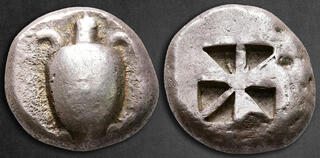| Savoca Numismatik GmbH & Co. KG > Online Auction 209 | Silver | Auction date: 28 April 2024 |
| Lot number: 77 Price realized: 380 EUR (Approx. 407 USD) Note: Prices do not include buyer's fees. | Show similar lots on CoinArchives Find similar lots in upcoming auctions on |
| Lot description: Islands off Attica. Aegina circa 525-500 BC. Stater AR 19 mm, 12,17 g Sea turtle with thin collar and row of dots down its back / Incuse square of "Union Jack" pattern with eight incuse segments. Very Fine Milbank Period I; Asyut Group II, 429; HGC 6, 428; SNG Copenhagen 502; SNG Delepierre 1502; SNG München 523-5; Dewing 1656; ACGC 114. The turtle is a well-known symbol associated with the ancient Greek island of Aegina and is commonly depicted on its ancient coins. These coins, known as "turtles," were minted in Aegina during the Archaic and Classical periods and were among the earliest coins in ancient Greece. The turtle symbolizes the island's maritime heritage and its importance as a naval power in the ancient world. Aegina was renowned for its skilled sailors and formidable navy, which played a significant role in the economic and political affairs of the region. On these coins, the turtle is typically depicted with a segmented shell and four flippers, sometimes with additional decorative elements. The reverse side of the coin often features an incuse square or other geometric patterns. The turtle coins of Aegina were widely circulated in the Mediterranean and served as a medium of exchange in trade and commerce. They are highly valued by numismatists and historians for their historical significance and artistic craftsmanship, offering valuable insights into the economic and cultural life of ancient Greece. Starting price: 150 EUR |  |


